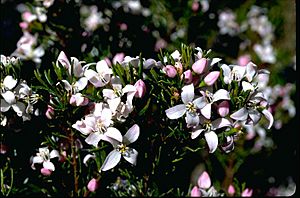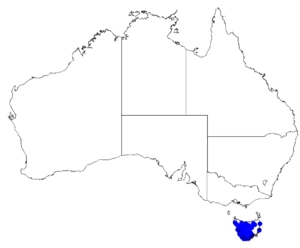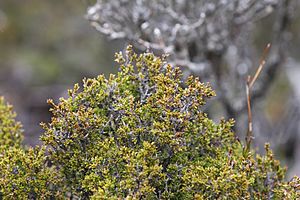Lemon-scented boronia facts for kids
Quick facts for kids Lemon-scented boronia |
|
|---|---|
 |
|
| Boronia citriodora on Needle Rock | |
| Scientific classification | |
 |
|
| Occurrence data from Australasian Virtual Herbarium |
The Boronia citriodora, also known as lemon-scented boronia, lemon plant, or lemon thyme, is a special kind of woody shrub. It is only found in Tasmania, Australia. This plant has leaves that look a bit like feathers and beautiful white to pink flowers. These flowers grow either by themselves or in small groups along the branches.
Contents
What Does Lemon Boronia Look Like?
The lemon-scented boronia is a woody shrub that can grow in different ways. Sometimes it lies flat on the ground, but usually, it stands upright and can reach up to 3 meters (about 10 feet) tall.
Leaves and Flowers
Its leaves are made up of smaller leaflets, usually between three and nine of them. The whole leaf can be from 7 to 25 millimeters long. The flowers are white or pink and grow on short stalks. Each flower has four small, triangular sepals (which protect the bud) and four petals. It also has eight stamens, which are the parts that produce pollen.
When Does it Bloom?
This plant usually flowers from November to February. After the flowers, it produces small, smooth fruits.
How it Got its Name
The Boronia citriodora was officially named in 1855 by a scientist named Joseph Dalton Hooker. He used notes from another scientist, Ronald Campbell Gunn. The name citriodora comes from the plant's strong lemon smell. Early settlers in Tasmania even called it the 'lemon-plant' because of its wonderful scent!
Different Types of Lemon Boronia
In 2003, another scientist, Marco Duretto, found that there are three slightly different types, or subspecies, of Boronia citriodora:
- Boronia citriodora subsp. citriodora: This type has smooth sepals and shorter leaves (less than 15 millimeters long). It grows in the Central Highlands of Tasmania.
- Boronia citriodora subsp. orientalis: This type has hairy sepals. You can find it on Ben Lomond and Mount Barrow.
- Boronia citriodora subsp. paulwilsonii: This type has smooth sepals but some of its leaves are longer (more than 15 millimeters). It grows in the southwest part of Tasmania.
Where Does Lemon Boronia Grow?
Lemon-scented boronia likes to grow in different places like open woodlands, heathlands, and sometimes near rainforests. It often prefers rocky areas.
Specific Locations
- The citriodora subspecies is found in the Central Highlands of Tasmania, usually in high places (above 900 meters). You can also find it in a few separate spots further south, like on Mount Field.
- The orientalis subspecies is only found on Ben Lomond and Mount Barrow.
- The paulwilsonii subspecies grows in the southwest of Tasmania, from Macquarie Harbour south and Mount Shea west.
Growing Lemon Boronia in Gardens
People sometimes grow Boronia citriodora in their gardens because it's a beautiful ornamental plant. It's quite tough and can handle lots of sun, shade, and wind. It can also grow in different types of soil, even dry, sandy, or very wet soils, and it can survive heavy frosts.


